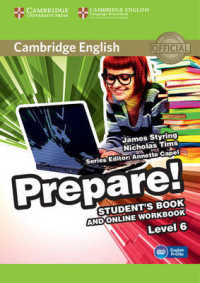- ホーム
- > 洋書
- > 英文書
- > Religion / Ethics
Full Description
People of Faith is a concise introduction to the history of Christianity as it has been lived and practiced. Beginning at the time of the New Testament the book moves chronologically through the main periods of Christianity, showing how history and belief have been shaped by the many diverse voices attempting to define the faith. * A succinct and student-friendly introduction to the history of Christianity as it has been lived and practiced * Focuses on the changing nature of faith: the five sections of the book look at Faith Defined, Faith Lived, Faith Reformed, Faith Challenged, and Modern Faith * Skillfully mixes the history of the Church with the stories of those who lived and shaped the faith, and the theology which emerged * Includes examples of personal narratives, hymns, and confessions throughout, along with a range of text boxes and sidebars to illustrate how Christianity was practiced and how official actions impacted on the experiences of ordinary believers * Ideal for beginning students with no prior knowledge of the history of Christianity.
Contents
Introduction.I. Faith Defined (to 600-Gregory the Great).A. The Church Takes Shape.1) Beliefs and practices.2) Canon and creed: the Deposit of Faith.3) Teachers of the church-Clement of Rome, Ignatius of Alexandria, Polycarp of Smyrna, etc.4) Early Christian centers-Alexandria, Carthage, Rome, Antioch.B. Christians and Roman Culture.1) Social origins of early Christians.2) Roman views of early Christians.3) Persecutions.4) Imperial Christianity.5) Spread of Christianity within and beyond the Empire.C. The Emergence of the Roman Catholic Church.1) Defining Orthodoxy-Nicaea, Constantinople, Chalcedon.2) Models of Orthodox practice-the Fathers of the Church; the rise of monasticism; holy women.3) The growth of the papacy; the legacy of Gregory the Great.II. Faith Lived (600 to 1415-Council of Constance).A. The Expanding Church (to Charlemagne).1) Converting barbarian invaders.2) Encounters with Islam.3) Charlemagne and the Church-Carolingian Renaissance.B. Piety and Practice.1) Renewal Movements.2) Crusades.3) Patterns of male and female devotion.C. Christendom.1) The Papacy.2) Spiritual and temporal authorities.3) Scholasticism.4) Architecture.5) Schism.6) Challenges-mysticism, popular movements, Savonarola, Wycliffe, Huss.III. Faith Reformed (1415 to 1648-Treaty of Westphalia).A. Renaissance Influences.1) Revival of Classical Learning.2) Formal and Informal Christianity.3) Rise of Spain and Portugal.B. Reformations.1) Martin Luther and Reformation in Germany.2) John Calvin, Geneva and Beyond.3) The Church of England.4) Reformation Radicals.5) New religious orders and Catholic reform.6) Council of Trent.C. Resolutions and Expansion.1) Religious wars and intrigue in the late 16th century.2) Thirty Years' War.3) Assuring a Protestant England.4) Catholic missionary efforts; New Spain, New France.5) Protestant colonies in the New World.6) Christianity in North America.IV. Faith Challenged (1648 to 1800).A. Faith and Reason.1) The Englightenment.2) Deism; the rise of Unitarianism.B. The Rise of Evangelicalism.1) Pietism.2) The Great Awakening.3) Methodism.4) Protestant foreign missions.5) Features of evangelicalism.C. Revolutions and Christian prospects in the United States and France.1) Separation of church and state.2) Christianity and democracy in the United States.V. Modern Faith (19th and 20th centuries).A. Trends in 19th-century Protestant Christian Thought .B. Catholicism.C. Christians and social/economic change-.1. new modes (Sunday schools, Salvation Army, YMCA, YWCA, Christian Endeavor, Temperance movements, etc.).2. new teachings (Papal encyclical, Social Gospel, Christian socialism, liberation theology, etc.).D. Revivalism and Mission.VI. Embattled, Empowered and Privatized Faith.A. The rise of Protestant fundamentalism.B. The rise of Pentecostal and charismatic movements.C. Christianity and fascism/Holocaust/communism.D. General trends in western Christianity since World War II..VII. Western Christianity and Global Christianity.A. The ecumenical impulse.B. Media and entrepreneurial impulses-the ubiquity of certain faces and forms of the Christian message .C. People of faith in a post-Christian west.D. Western Christianity and global Christianity: trends and prospects in the new millennium








